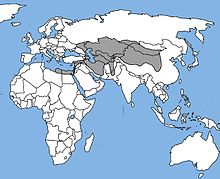| Long-eared hedgehog[1] | |
|---|---|

| |
| Scientific classification | |
| Domain: | Eukaryota |
| Kingdom: | Animalia |
| Phylum: | Chordata |
| Class: | Mammalia |
| Order: | Eulipotyphla |
| Family: | Erinaceidae |
| Genus: | Hemiechinus |
| Species: | H. auritus
|
| Binomial name | |
| Hemiechinus auritus (S. G. Gmelin, 1770)
| |
| Subspecies | |
|
H.a. auritus
| |

| |
| Geographic range of the long-eared hedgehog | |
The long-eared hedgehog (Hemiechinus auritus) is a species of hedgehog native to Central Asian countries and some countries of the Middle East. The long-eared hedgehog lives in burrows that it either makes or finds and is distinguished by its long ears. It is considered one of the smallest Middle Eastern hedgehogs.[3] This hedgehog is insectivorous[4] but may also feed on small vertebrates and plants.[3] In captivity they can live for over 7 years.[5]
Since the long-eared hedgehog is naturally parasite prone and can carry diseases as bad as plague, it is highly recommended that, if kept as a pet, it should be purchased from a respected dealer. Wild hedgehogs have been found to carry Rhipicephalus sanguineus, the brown dog tick, which can transmit Boutonneuse fever.[6]
- ^ Hutterer, R. (2005). Wilson, D.E.; Reeder, D.M. (eds.). Mammal Species of the World: A Taxonomic and Geographic Reference (3rd ed.). Johns Hopkins University Press. p. 215. ISBN 978-0-8018-8221-0. OCLC 62265494.
- ^ Stubbe, M.; Samiya, R.; Ariunbold, J.; Buuveibaatar, V.; Dorjderem, S.; Monkhzul, T.; Otgonbaatar, M.; Tsogbadrakh, M.; Zagorodniuk, I.; Hutterer, R.; Kryštufek, B.; Yigit, N.; Mitsainas, G.; Palomo, L. (2021). "Hemiechinus auritus". IUCN Red List of Threatened Species. 2021: e.T40607A197510528. doi:10.2305/IUCN.UK.2021-1.RLTS.T40607A197510528.en. Retrieved 12 November 2021.
- ^ a b Qumsiyeh, M. B.. (1996) Mammals of the Holy Land. Texas Tech University Press, Lubbock Texas. pp. 64–66 ISBN 089672364X.
- ^ Poddar-Sarkar, M.; Raha, P.; Bhar, R.; Chakraborty, A. & Brahmachary, R. (2011). "Ultrastructure and lipid chemistry of specialized epidermal structure of Indian porcupines and hedgehog". Acta Zoologica. 92 (2): 134. doi:10.1111/j.1463-6395.2010.00452.x.
- ^ de Magalhaes, J. P. & Costa, J (2009). "A database of vertebrate longevity records and their relation to other life-history traits". Journal of Evolutionary Biology. 22 (8): 1770–4. doi:10.1111/j.1420-9101.2009.01783.x. PMID 19522730.
- ^ Cunningham, P. L. & Thompson, K. (Spring–Summer 2000). "Tick-host relationships as determined from wildlife in the United Arab Emirates (Acarina, Fam. Ixodidae) – a preliminary study" (PDF). Tribulus. 10 (1): 16–17.
